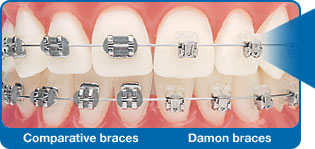What are Self-Ligating Braces?
Braces have been used for many years to help straighten crooked teeth in children and adults. In recent years there have been improvements and advancement in braces which make them more accessible and comfortable for all ages or patients. Traditional braces use brackets, archwires, and bands to apply steady pressure to the teeth in an effort to make them straighter. Regular visits to your orthodontist are needed to adjust the archwires and bands to keep your braces working properly. New self-ligating braces use clips instead of rubber bands, and are more comfortable and effective than traditional braces.

Traditional Braces vs.Self-Ligating Braces
Both traditional and self-ligating braces are effective dental appliances used to straighten teeth. Traditional braces use brackets applied to the teeth, archwires threaded through the brackets, and rubber bands to hold the archwires in place. Self-ligating braces also use brackets applied to the teeth, archwires threaded through the brackets, but instead of using rubber bands self-ligating braces use special clips built into the brackets to hold the archwire into place.
Effectiveness of Self-Ligating Braces
You will need to wear traditional braces from one to three years depending on the severity of your misalignment. Some orthodontists feel self-ligating braces are a better choice because the time you wear them is generally shorter than traditional braces. The clips create less friction between the archwire and the brackets, making it easier for the braces to guide your teeth to a normal position. You also have to go to the orthodontist less frequently for adjustments since there are no rubber bands.
Types of Self-Ligating Braces
There are two main types of self-ligating braces; passive and active. Passive self-ligating braces use a smaller archwire and create less friction letting the teeth move more freely. Active self-ligating braces use a thicker archwire and use more pressure to aggressively move your teeth into position. Although active self-ligating braces use more pressure, there is not a greater level of discomfort. Many people find self-ligating braces to much more comfortable than traditional braces which use rubber bands. Self-ligating braces may also be fitted with clips which are metal or ceramic. Ceramic clips are less noticeable and blend in with your teeth.
Benefits of Self-Ligating Braces
Self-ligating braces have many benefits. They are more comfortable, need less adjusting than traditional braces, move teeth into place quickly, your teeth are easier to clean since there are no rubber bands to collect food and plaque, and the brackets are smoother. Many orthodontists and patients prefer self-ligating braces for these reasons.
Crooked teeth can be an embarrassment and be uncomfortable. With today’s new technology, braces can be easy to wear. and an effective treatment for crooked teeth. Your dentist and orthodontist will determine if self-ligating braces are a good choice for you. Self-ligating braces are available for children and adults. If you have crooked teeth, ask your orthodontist about the possibility of using self-ligating braces to help you have the smile you deserve.
